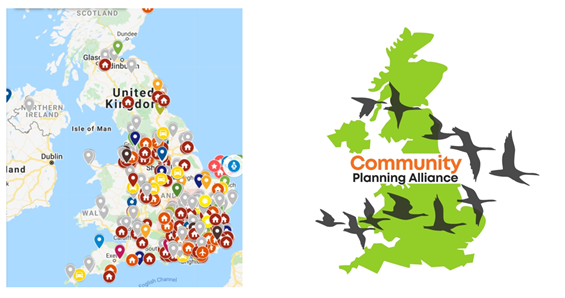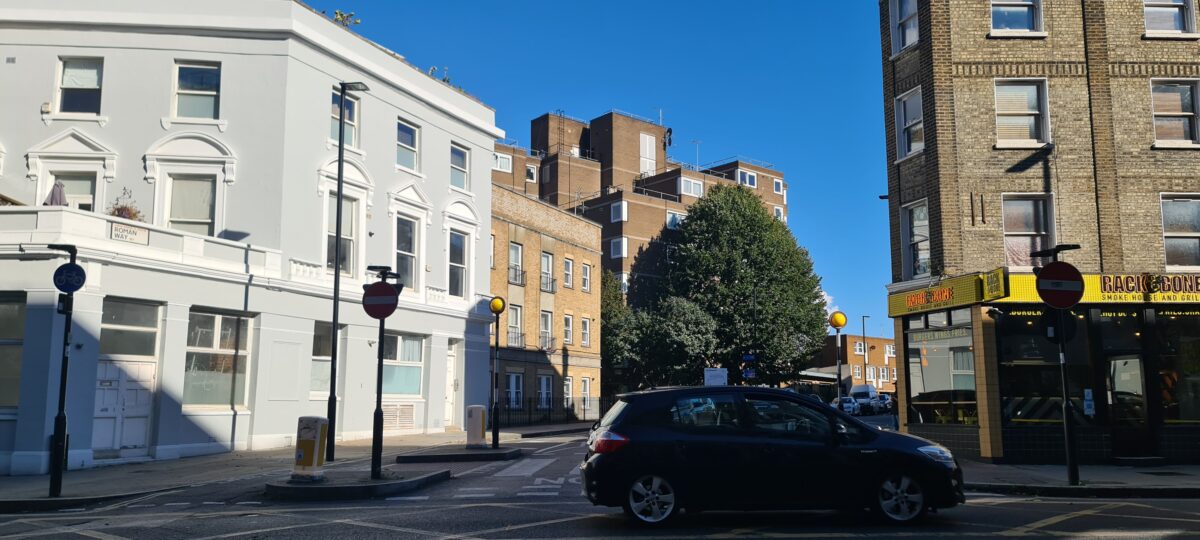Politicians may be missing the point when they reference red or blue election walls. Should they instead be focusing on multi-coloured walls, and the real walls of real houses?
The Community Planning Alliance map[1], was launched in March 2021, already includes 525 active planning campaign groups. It is a clear indicator that all is not well at grassroots level in our communities across all areas of the country. The planning system is potentially facing a popular revolt.

Until now, those groups were on their own – yet the battles they are fighting are very similar. These campaigners never thought they would be campaigners, most wish they did not have to be, and some, like me, have become full-time campaigners.
Why?
Local communities face many problems… Councils are, on the whole, disinterested in residents’ views, or even obstructive. Developers call the shots, targeting areas with no five-year housing supply, and regularly reneging on promises of affordable housing, using the viability loophole. (What other industry is guaranteed a profit of 15-20% anyway?).
Trust in the system is virtually non-existent. This, from a report by Grosvenor[2] in 2019 says it all:
“This year, we conducted the largest ever canvassing of public trust in placemaking in the UK, finding that just 2% of the public trust developers and only 7% trust local authorities when it comes to planning for large-scale development.
The research also unpicks the drivers of this lack of trust − the biggest being the perception that developers only care about making or saving money, with 75% of respondents identifying this as a reason for their lack of trust.”
Green space, countryside, hedgerows, clean air, rivers and streams, are all at risk in the relentless drive to meet government’s 300,000 pa housing target, deliver its roads programmes, and even its renewable energy targets. Never has land been under so much pressure, from providing the food that we eat, to use for housing and commercial development, biofuels, off-setting and tree-planting.
And, of all those pressures, it is the high house-building targets shared by all political parties which are causing the most controversy. For years, the populist line we have all been fed is that to solve the housing crisis, we need to just build more houses.
Three misunderstood points about the ‘housing crisis’
- The 300,000-homes per annum target is based on out-of-date statistics, and population growth is slowing dramatically. Local level data has been found to overstate population growth in around 50 cities and towns.
- Housing targets do nothing to address real affordability or solve the housing market problems. Housing waiting lists remain stubbornly high, chiefly because very few social houses are being built – only 6,566 last year – and more are being sold off or demolished each year than built. Then there’s long term empty homes and the holiday or second home problem, all of which are housing stock unavailable to people who need homes.
- Developers release new properties into the market when it does not depress prices. If prices start to fall, they will slow new build supply.
So, you might get a shiny new housing estate at the edge of your town or village, but it will be car-dependent and many of the properties will be unaffordable to your children. That’s even if they are described as ‘affordable’, which is actually only a 20% reduction off market price.
That’s why the Community Planning Alliance campaigns for three solutions :
- Housing policies that address need, based on accurate and up-to-date, bottom-up local household projections, ensuring that the housing delivered is truly affordable (and based on local wages rather than discount to market value). We support Shelter’s campaign for social housing, and we support the campaign of Empty Homes, to ensure that our existing housing stock is far better used.
- Enhanced community participation where residents can really shape their future with their elected councils, not, as now, have planning imposed on them. We argue for a process of ‘engage, deliberate, decide’, instead of the current ‘decide, announce, defend’. There needs to be a rebuilding of trust in the system and to start to do that, there needs to be real debate at the start of local plan-making so that issues and concerns are addressed.
Statements of Community Involvement need to be more accessible and improved, to include, for example, minimum standards such as Gunning Principles[3] or the seven best practice principles of the Consultation Institute[4], which ensure that consultations are held when decisions have not already been made, that there is sufficient information available for stakeholders to respond, sufficient time for responses and that responses are actually taken into account. We also call for Local Plan Votes, in the same way that Neighbourhood Plans are subject to a referendum.
3. Taking better care of our precious environment. The UK is one of the most nature-depleted countries in the world and the recent Natural History Museum report in advance of COP26 noted[5] that we have led the way in the destruction of the natural environment. Build, build, build at all cost is not acceptable, nor is token environmental mitigation.
If each of the 525 groups on the map were to count only 1,000 supporters (and we know that some have many, many more, some as many as 10,000), that’s over half a million people active in the planning and local political system. What will be the impact if each of those groups decides to put up independent candidates in local elections? There is potential for a re-shaping of the political order. It is a multi-coloured, grassroots wall that government and opposition should heed.
[1] Community Planning Alliance: grassroots map (google.com)
[2] Grosvenor – Grosvenor Britain & Ireland addresses lack of trust in UK developers & planning system
[3] The Gunning Principles.pdf (local.gov.uk)
[4] The Consultation Charter – The 7 Best Practice Principles — The Consultation Institute
[5]UK has ‘led the world’ in destroying the natural environment | Natural History Museum (nhm.ac.uk)


One reply on “Multi-coloured walls?”
Just about sums up what we stand for. Well said Rosie.